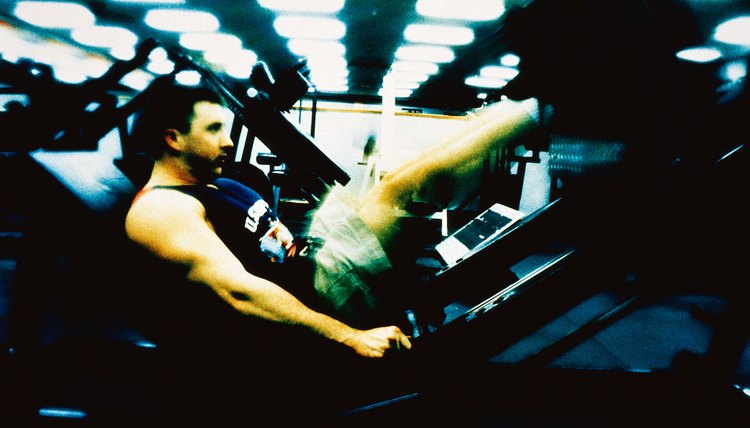Lying Leg Press vs. Seated Leg Press

When it comes to toning and sculpting your legs, sometimes the most tried-and-true gym equipment delivers the best results. To tighten and strengthen your legs, add the classic leg press to your workout routine.
There are two types of leg presses -- the seated leg press and the vertical leg press. Both work to strengthen and sculpt the entire leg, engaging multiple muscle groups with each repetition.
Vertical Leg Press
The vertical leg press, also known as a “sled style” leg press, uses weighted plates attached directly to the sled. The weighted discs are mounted on rails and the user sits below the sled, pushing it upward with their feet. A vertical leg press is equipped with a safety bracket that prevents the weights from slamming down or trapping the user.
Seated Leg Press
The seated leg press is also known as the cable leg press. In this press, the user sits in an upright position and pushes weighted plates forward with their feet. The weighted plates are attached to stacked weights by a long steel cable.
Muscles Used
Both types of leg presses work the same muscles and deliver similar results, so choosing a machine should be about which one you feel most comfortable using.
Both sled and cable leg presses work to tone the calves, hamstrings and quadricep muscles. The muscles are strengthened as you pull your knees to your body while bearing weight from the leg press. The muscles engage and flex against the weight, which builds muscle fiber and creates a tighter look in your legs.
Getting Started
To start, choose the amount of weight you feel is appropriate. The rule of thumb is to press about two times your body weight. Secure the selected weight in place with the metal pin. Your legs should be at a 90-degree angle before you begin. After you lower the weight’s safety bar, sit down (cable style) or lay back (sled style) with knees bent and feet lightly resting against the weight and slowly extend outward.
Proper Form
With your knees at a 90-degree angle, place your feet flat against the board, about hip-width apart. Legs should be in line with the knees, not bending inward or outward.
Exhale as you push the weight away slowly, making sure you don’t lock your knees. Inhale as you slowly bring the weight back towards your body, making sure you don’t slam the weight back. You should feel enough pressure in the legs to be uncomfortable, but should not feel pain or straining.
Lifting the Proper Weight
To gauge the amount of weight needed to tone and strengthen, try a few repetitions. You should feel a good amount of resistance and pressure, but your movement should still be relatively fluid. Though pressing two times your body weight is average, beginners may want to build up to this weight, while those with good leg strength may add weight as they progress.
Frequency
A leg press workout should be performed two to three times a week, with at least one day of rest in between. At each workout, aim for four sets of leg presses, with 6 to 10 repetitions in each set.
Stretching
Never use a leg press machine without stretching after. A set of static lunges and quadriceps stretches will help ensure your knees, quadriceps and hamstrings don't get too tight.
Safety Tips and Warnings
Avoid injury by using proper form and always double-checking that weighted plates are properly latched in place. Though you may be eager to add weight, it is not advisable to increase your weight by more than 20 percent between workouts. Allowing your muscles to slowly strengthen by steadily increasing weight and including "rest days" will help keep you strong and injury-free.
References
Writer Bio
Stephanie Rutherford-Scott has more than 10 years of experience in print and multimedia journalism for Booth and Gannett Corp. Her work has been published by the Associated Press and Gannett News Service in news publications throughout Michigan and the United States. She received her Bachelor of Arts in creative writing and journalism from Western Michigan University.
